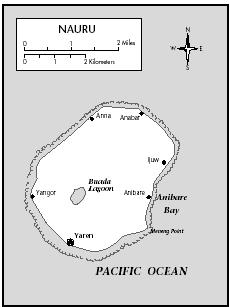
Nauruan is the indigenous name used on official documents. Politically, the country is called the Republic of Nauru (RON).
ALTERNATIVE NAMES
Pleasant Islander. Other spellings have appeared, such as Naoero on the national crest.
ORIENTATION
Identification. The name Pleasant Island was used by the first Europeans in reference to the lush vegetation and friendly inhabitants. Nauruans are attempting to recreate that image after the devastation left by phosphate mining.
Location and Geography. Nauru is a single, almost circular island, 37 miles (60 kilometers) south of the equator. It is over 185 miles (300 hundred kilometers) from its nearest neighbor, Ocean Island, and nearly 500 miles (800 kilometers) from Kiribati to the east and the Marshall Islands to the northeast. The Solomon Islands are 744 miles (1,200 kilometers) to the southwest. Topographically, Nauru is shaped like a hat, with a coastal fringe forming the brim and the raised interior forming the crown. The interior, known as Topside, makes up four-fifths of the island; it has been mined for phosphate, and now is an almost impassable area of calcite pinnacles. Buada lagoon is in the raised interior. The island covers a total area of 13 square miles (21 square kilometers). The island is a raised reef consisting of calcite and phosphate on a volcanic base. Nauru has very steep sides that drop down to the ocean floor. This has made anchorage for shipping difficult and necessitated the use of a special mooring device.
Demography. The population has been estimated to be over nine thousand, of which indigenous Nauruans account for about six thousand. In the 1992 census, the population was projected to reach 8,100 by 1996, with a growth rate of 4.3 percent. The remainder of the population includes Pacific islanders from Kiribati, Tuvalu, and Fiji, along with Chinese, Filipinos, Indians, Australians, and New Zealanders. The population is relatively young, with 66 percent of the people under age 24. Population growth has been a major concern throughout the twentieth century. Attempts to reach a total of 1,500 were set back by the influenza epidemic of 1919, but that figure was reached in 1932, a date that now is celebrated as a national holiday. However, the population was severely reduced by starvation, disease, and bombing during World War II. In 1943, of the 1,201 Nauruans deported to Truk by the Japanese, 464 died, leaving 737 to return on 31 January 1946. The population reached 1,500 again in 1950 and has continued to grow. The nation continues to espouse a positive population policy. A very small proportion of Nauruans live overseas, but many visit Australia, New Zealand, and other countries for purposes of work or education or to visit family, and return home.
Linguistic Affiliation. Nauruan is classified as a Micronesian language but does not fit easily within subgroupings of Austronesian languages. It shares some words with Kiribati but is recognized as standing alone. Nauruans are writing their own dictionary. All Nauruans speak English as well as their own language.
Symbolism. The frigate bird is a major symbol; it is found on the fin of Air Nauru planes and appears as the official logo. The crest consists of two palm trees encircling an orb that includes a Christian cross above a resting frigate bird and a flower. Above the orb is a twelve-pointed star representing the twelve tribes of Nauru. Beneath the orb are the words "God's Will First," indicating the Christian basis of the community's way of life. Phosphate has become another symbol, forming the basis of the nation's wealth.


